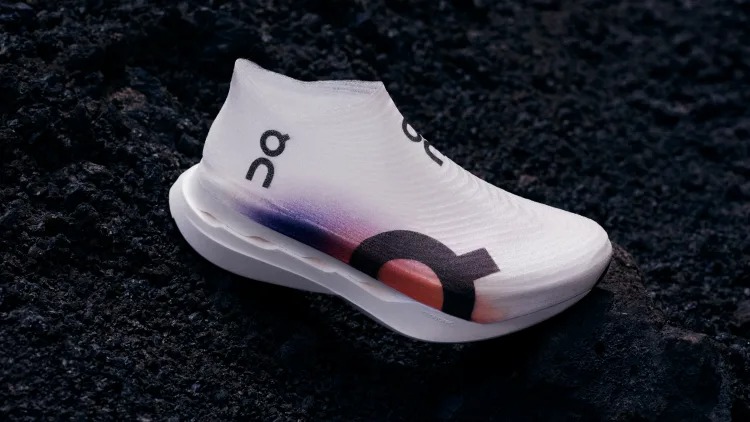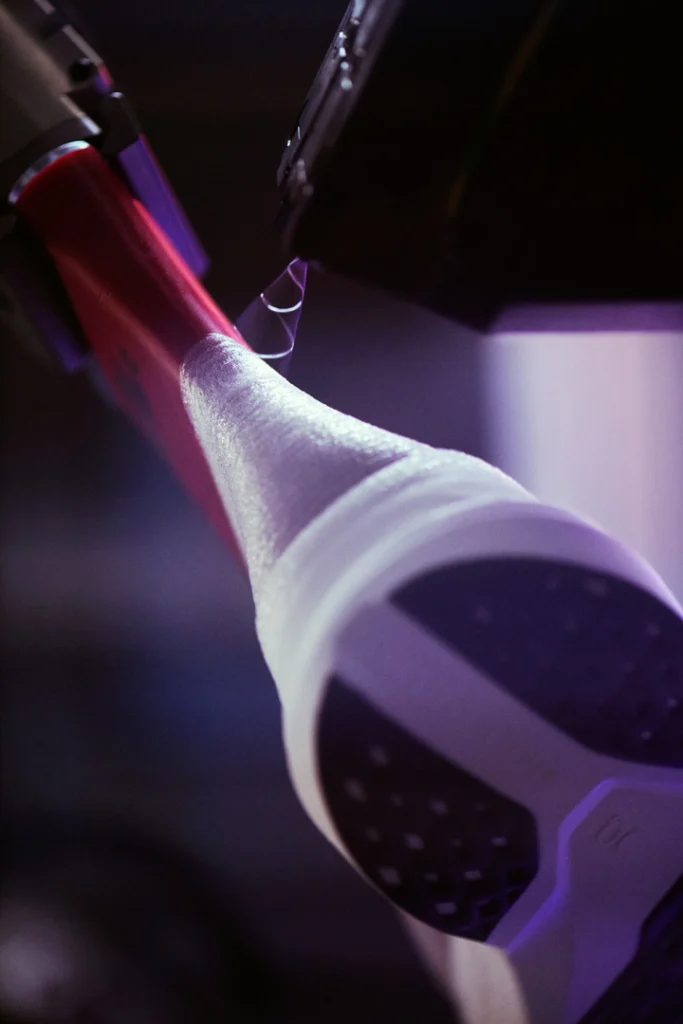- | 8:00 am
On’s new Cloud sneaker uses spray-on plastic to build a shoe in 6 minutes
Four years in development, On is debuting its spray-on performance shoe technology that makes sneakers lighter, less wasteful, and far faster to produce.

Inspiration comes in many forms. In this case, it was a hot glue gun on Halloween.
A senior member of On’s innovation team, Johannes Voelchert, stumbled across a video in which a crafter squeezed a thin filament of hot glue into a fluff of spider web. They wondered, could create a shoe the same way, and rather than laughing at the idea, team at On took it quite seriously.
“My brief was, ‘you go wild, go crazy, and I pay,” says Ilmarin Heitz, senior director of footwear at On.
Four years later, a one-person experiment swelled to include 20 designers and engineers inside the Swiss footwear company. The result is a new paradigm in sneaker production called Lightspray. By placing a last (or foot form) on a robot arm, On can spray a shoe’s entire upper (its top part) from a single continuous filament in just three minutes.

That’s important because the most difficult part of a sneaker to produce is its upper. Fluffy outsoles are produced in a mold, but uppers involve all the challenges of traditional garment production, including various fabrics, tension wires, stitching, and glue. “Modern shoe making is not so modern,” says Heitz. “It’s just using 2D patterns.. and we’re trying to wrap them around a very complex 3d shape.
When you add up all of the suppliers involved in the process of making an upper, it takes days of work to produce a sneaker—which can include as many as 100 parts. Mix in real world logistics and shipping, and you’re closer to weeks. But Lightspray shoes are constructed with just five parts, requiring in six minutes total.
Lightspray technology debuted in the Cloudboom Strike LS—a shoe that was first offered in a limited run in April, and will be available again this fall for $330. And it combines a few major trends in footwear. Long before hot glue guns were involved, the industry had been experimenting with 3D printed products, ranging from Adidas’s Futurecraft 4D outsoles and Strung uppers to Nike’s Zoom Superfly Elite track spikes to Vivobarefoot’s upcoming custom tailored footwear. The promise is part efficiency, and part pinpoint performance control. But thus far, additive manufacturing hasn’t challenged industry production standards.
At the same time, performance running shoes are becoming both bouncier and lighter. It’s a trend that started with Nike’s marathon breaking Zoom Alphafly, which return as much as 4% of someone’s stride, and is being accelerated by products like Adidas’s Adizero Pro Evo, an energy returning running shoe that weighs just 130g.

HOW ON’S CLOUDBOOM STRIKE LS WORKS
On’s Cloudboom Strike LS is an energy-returning running shoe that shaves weight and complexity by leveraging some of the best efficiencies of 3D printing.
To produce a Lightspray shoe, the robot arm holds the outsole up to a sprayer. The arm rotates the shoe, while the spray extrudes TPU almost like a fancy garden hose nozzle, spiraling the stream as a helix. That stream lands onto the last as a single continuous string, bonding to the outsole and to itself without glue. But even though it’s a single material, On can still tune the breathability, stretch, and support of the upper in different spots through two methods: moving the shoe farther or closer to the stream, or by increasing or decreasing the diameter of that helix. Heitz says that the ensuing material is so form fitting that On’s athletes have opted to wear the shoe without a sock.
This upper production stage takes a few minutes. After that, one robot arm passes the shoe to another robot. That robot sprays the shoe with color which cures in three minutes. Then the shoe can be worn immediately.

On claims this production method on the upper isn’t just faster, it reduces 75% of the carbon footprint of that part. (The TPU is technically recyclable if the shoe is deconstructed, and On says it could use a recycled TPU in their shoe.)
“One of the visions was, imagine if you go to a race, you have one of these robots with you, and on race day, if it’s wet or dry, the robot sprays you a perfect shoe for the moment,” says Heitz. “And at the end of the race you take it off, recycle it, and go to the next race.”
That said, On is focusing first on the production and performance of the Cloudboom Strike LS before tuning its environmental impact—though Heitz explains the most problematic component would be its carbon fiber energy returning plate, which is technically recyclable, but requires significant energy to do so.
Long term, On is imagining the same possibility that Adidas did years ago: Using Lightspray to move production from Asia directly into local markets around the world, expediting production, lowering impact, and responding to trends faster than ever before.
“There are no limits to this technology,” says Heitz. “You can produce what you want, where you want, and only as much as you want.”





































